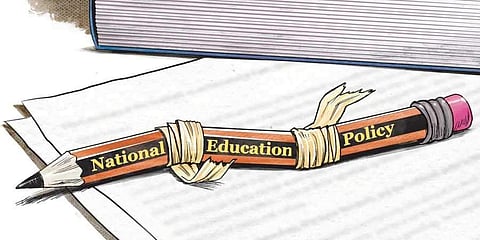

The aim of NEP 2020 was clear – to replace the Congress-era policy of 1986 and bring in a 21st century vision of education. I do not agree that there is any stamp of saffron on it. It is a pragmatic and forward-looking education policy. The National Education Policy 2020 document promises big and bold moves and a new order. The policy has also been criticised due to the legal complexities surrounding the applicability of two operative policies, namely The Right to Education Act, 2009 and the New Education Policy, 2020. The NEP 2020 is a welcome and ambitious re-imagination of India’s education system into a modern, progressive and equitable one. Successful execution of this policy calls for dramatic simplification of decision-making structures and re-prioritisation of budgetary resources in months and years to come.
Language controversy
NEP states that the medium of instruction for children of classes up to V will be in mother tongue/regional language. However, this NEP 2020 feature contradicts the Supreme Court judgement of June 5, 2014 which held that Article 19(1)(a) of the Constitution of India guarantees the fundamental right of parents to choose the medium of instruction in which their children study in school – “A child, and on his behalf his parent or guardian, has the right to choose the medium of instruction at the primary stage under Article 19(1)(a)”. The first big recalibration was on language.
The focus has shifted from Hindi to English. The Centre replaced the contentious clause, doing away with the mention of Hindi vis-a-vis the three-language formula and a policy of “no language will be imposed on any state”. The policy also states that Sanskrit will be “mainstreamed” with strong offerings in school and higher education. It will be included as one of the language options in the three-language formula at schools. Sanskrit is not the language of science and technology.
Then, there’s a clause 4.17 of the NEP which dwells on the relevance, importance and beauty of Sanskrit. “Sanskrit will be offered at all levels of the school and higher education as an important, enriching option for students, including as an option in the three language formula.” It can be argued that this is only a recommendation. But given how fervently the ruling class has been pushing for the use of Hindi and Sanskrit nationally, it gives rise to apprehensions. This has been objected by many states ruled by opposition parties. Many in the state have expressed deep concern over some of the proposals made by the state government.
The proposals are part of position papers for inputs sent to the Union Government to be included in the curriculum under NEP. It suggests incorporating mathematical concepts from ancient Bharat, while drawing a contrast to the mathematical concepts which have its origins in Europe. It also recommends introducing “certain sutras” of Vedic mathematics for “fast mental calculation”. The Pythagoras theorem is being questioned. We need to evolve and expand our horizons of knowledge, and we cannot insist that our students restrict their horizon to just India-based experts and expertise.
There is a persistent mismatch between the knowledge skills imparted and the jobs available. This has been one of the main challenges that has affected the Indian education system since Independence. NEP 2020 fails to check this, as it is silent on education related to emerging technological fields like artificial intelligence, cyberspace, nanotech, etc. Experiential learning has to be given more prominence and teachers need to imbibe creative thinking in students.
The focus should be on core subjects through programmes like STEM education. Innovative teaching should be introduced using new technologies. Preference should be given to conceptual understanding rather than rote learning. It should support feedback-oriented evaluation, making students understand where they are going wrong. Teachers can regularly evaluate students based on the learning outcomes.